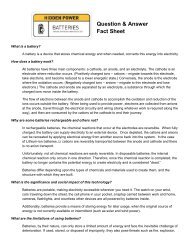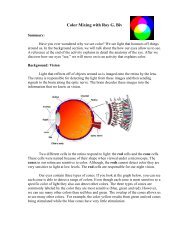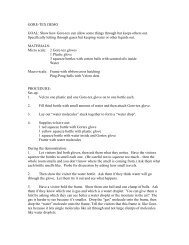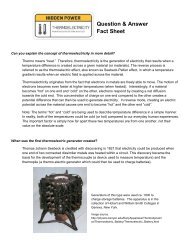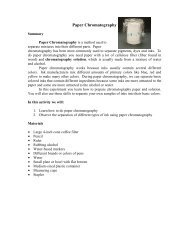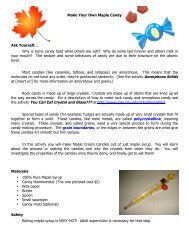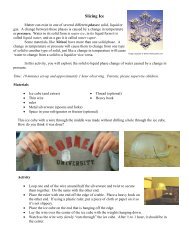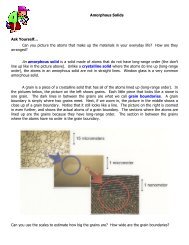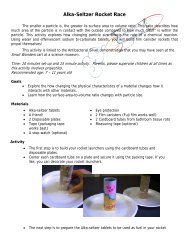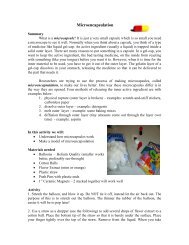Executive Summary Final - the Center for Nanoscale Science - an ...
Executive Summary Final - the Center for Nanoscale Science - an ...
Executive Summary Final - the Center for Nanoscale Science - an ...
Create successful ePaper yourself
Turn your PDF publications into a flip-book with our unique Google optimized e-Paper software.
IRG2: Powered Motion at <strong>the</strong> <strong>N<strong>an</strong>oscale</strong><br />
to overcome <strong>the</strong> problem of steric hindr<strong>an</strong>ce in <strong>the</strong> lattice. We have designed adam<strong>an</strong>t<strong>an</strong>etrithiol<br />
molecules functionalized with azobenzenes to create space around each azobenzene unit <strong>the</strong>reby<br />
providing sufficient spatial freedom <strong>for</strong> switching of <strong>the</strong> entire monolayer. Also, <strong>the</strong> adam<strong>an</strong>tyl<br />
cage electronically decouples <strong>the</strong> azobenzene moiety from <strong>the</strong> substrate, <strong>the</strong>reby improving<br />
switching efficiency. Syn<strong>the</strong>sis of molecules is being done by <strong>the</strong> Tour group <strong>an</strong>d measurements<br />
by <strong>the</strong> Weiss group. The effects of <strong>the</strong> power of UV <strong>an</strong>d visible lights on <strong>the</strong> rates of<br />
isomerization will also be studied in order to establish <strong>the</strong> minimum power required <strong>for</strong><br />
triggering photo-switching.<br />
Less constrained unte<strong>the</strong>red motion is possible with molecular n<strong>an</strong>ocars. The syn<strong>the</strong>sis <strong>an</strong>d ringopening<br />
meta<strong>the</strong>sis polymerization activity of two n<strong>an</strong>ocars functionalized with <strong>an</strong> olefin<br />
meta<strong>the</strong>sis catalyst was completed in 2010. In <strong>an</strong> ef<strong>for</strong>t to elucidate <strong>the</strong> mech<strong>an</strong>ism of movement<br />
of n<strong>an</strong>o-vehicles on nonconducting surfaces, <strong>the</strong> syn<strong>the</strong>sis of five fluorescently tagged n<strong>an</strong>ocars<br />
was completed <strong>an</strong>d <strong>the</strong>ir optical properties were determined. The syn<strong>the</strong>sis <strong>an</strong>d imaging by<br />
sc<strong>an</strong>ning tunneling microscopy of a n<strong>an</strong>o-dragster were completed. A new class of n<strong>an</strong>o-vehicles<br />
incorporating tr<strong>an</strong>s-alkynyl(dppe)2 ru<strong>the</strong>nium-based wheels were also syn<strong>the</strong>sized. A<br />
computationally non-dem<strong>an</strong>ding method <strong>for</strong> simult<strong>an</strong>eously determining multiple trajectories of<br />
single molecules was developed. Single molecule fluorescence imaging of dye-labeled n<strong>an</strong>ocars<br />
at room temperature was also investigated.<br />
M<strong>an</strong>y of <strong>the</strong>se motors – at both <strong>the</strong> micro <strong>an</strong>d n<strong>an</strong>o scales – produce enh<strong>an</strong>ced functionality if<br />
<strong>the</strong>y c<strong>an</strong> interact with external fields. The IRG has been developing a new type of field with<br />
which to control motors of diverse types: a st<strong>an</strong>ding surface acoustic wave. This active<br />
separation technique uses st<strong>an</strong>ding surface acoustic wave to separate <strong>an</strong>d/or pattern a wide r<strong>an</strong>ge<br />
of n<strong>an</strong>omaterials, including catalytic, biological <strong>an</strong>d molecular motors. The excellent energy<br />
confinement of SAWs propagating on a piezoelectric substrate makes this particle separation<br />
device highly energy efficient.<br />
A final area of IRG<br />
investigation in 2010<br />
involves <strong>the</strong> active control<br />
of plasmonics using<br />
molecular machines: <strong>the</strong><br />
IRG has demonstrated a<br />
molecular-level active<br />
plasmonic device based on<br />
<strong>the</strong> <strong>for</strong>mation of plasmonexciton<br />
states by assembling J-aggregate molecules on <strong>an</strong> array of gold n<strong>an</strong>odisks. By ch<strong>an</strong>ging<br />
<strong>the</strong> incident <strong>an</strong>gle of incoming light, we observed plasmon-exciton coupling of variable<br />
strengths. We have also demonstrated a frequency-addressed plasmonic switch by embedding<br />
uni<strong>for</strong>m gold n<strong>an</strong>odisk /holes into dual-frequency responsive liquid crystal molecules (DFLCs).<br />
This DFLC-based active plasmonic system demonstrates <strong>an</strong> excellent, reversible, frequencydependent<br />
switching behavior <strong>an</strong>d could be used in future integrated n<strong>an</strong>ophotonic circuits.<br />
Owing to <strong>the</strong> signific<strong>an</strong>ce of <strong>the</strong>se works, <strong>the</strong>y have been selected as cover images of several<br />
journals (figure above). We have also developed a wide r<strong>an</strong>ge of plasmonic devices <strong>an</strong>d currently



